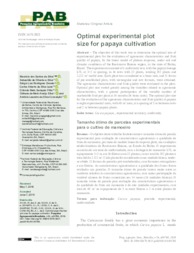Optimal experimental plot size for papaya cultivation.
Optimal experimental plot size for papaya cultivation.
Author(s): SILVA, M. dos S. da; SILVA, S. de O. e; DONATO, S. L. R.; LEDO, C. A. da S.; SAMPAIO FILHO, O. M.; SILVA, G. de M. A.
Summary: The objective of this work was to determine the optimal size of experimental plots for the evaluation of agronomic characteristics and fruit quality of papaya, by the linear model of plateau response, under soil and climatic conditions of the Recôncavo Baiano region, in the state of Bahia, Brazil. The experiment consisted of a uniformity test, with the papaya lineage L78, at 3×2 m spacing, in 16 rows with 22 plants, totaling 352 plants and 2,112 m2 useful area. Each plant was considered as a basic unit, and 11 forms of pre-established plots, with rectangular and row formats, were obtained. The agronomic characteristics and fruit quality were evaluated in the plots. Optimal plot size varied greatly among the variables related to agronomic characteristics, with a greater participation of the variable number of marketable fruit per plant at 14 months (16 basic units). The optimal plot size for the evaluation of the agronomic characteristics and fruit quality in papaya is eight experimental units, with 48 m2 area, at a spacing of 3 m between rows and 2 m between papaya plants.
Publication year: 2019
Types of publication: Journal article
Unit: Embrapa Cassava & Fruits
Keywords: Carica Papaya, Mamão
Observation
Some of Embrapa's publications are published as ePub files. To read them, use or download one of the following free software options to your computer or mobile device. Android: Google Play Books; IOS: iBooks; Windows and Linux: Calibre.
Access other publications
Access the Agricultural Research Database (BDPA) to consult Embrapa's full library collection and records.
Visit Embrapa Bookstore to purchase books and other publications sold by Embrapa.

